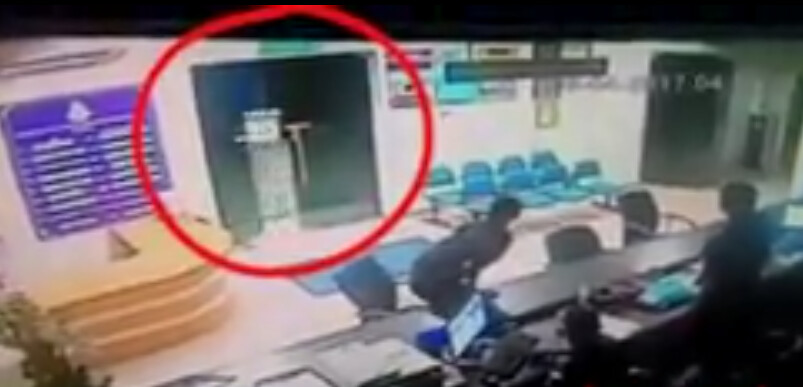
A Kuala Lumpur-based Geographical Information System (GIS), mapping and remote sensing consultant who analysed the satellite image further attested to this. They reveal, "Johor (southern state of peninsular Malaysia) does not have natural rock formations and what is seen in the satellite image is man-made. The lines could be walls or trenches," he said. But, besides supporting this hypothesy, they don't rule out former logging trails, fluvial networks caused by receding waters of a dam which is the result of sedimentation.
On the possibility that some of the lines seen on the satellite image were modern-day fences, the consultant said, "Fences are never built around dams in the country. I suspect these could be 'fences' built long ago." He said it was necessary for the authorities to go and verify the authenticity of the site.
Theories and theories......
Scholars & Historians are speculating:-
1. That the city was part of the "Ayuthia Kingdom" (Ancient Siam now known as Thailand) & may be the unidentified Naksat city of the Siamese folklore. Hence, the the word "Gelanggi" could be a mispronounciation of the Thai word "Ghlong-Keow" meaning box of emeralds or treasury of jewels.
2. The Malay annal, "Sejarah Melayu" (meaning History of Malay) has mentioned that the main fort of Kota Gelanggi was made of black stone & was named "Kota Batu Hitam" in Malay meaning "Black Rock City". Sejarah Melayu is a 17th Century Malay text.
3. Ancient Tamil inscriptions otherwise inform us that during the era of south Indian Chola Dynasty in 1025, after destroying the Malay Kingdom, Gangga Nagara.
(Some time ago, I wrote about the "the Bujang Valley" finding leading to ancient Indian settlers in the northern part of peninsular Malaysia)
4. Local Folklore:
According to the locals, Kota Gelanggi was a Kingdom. The King of Gelanggi had a very beautiful daughter. The princess was engaged to Raja Mambang. Many other Kings from the neighboring countries proposed to marry her. A war broke out between Raja Mambang, the princess's fiance with another King, Raja Rusul from Bera. The city was destroyed in the war.
Conclusive Finding?
On April 28th 2006, the Malaysian National News Service (Bernama) reported that the "Lost City does not exist". Khalid Syed Ali, the Curator of Archaeology in the Department's Research and Development Division, said a team of government appointed researchers carried out a study over a month in July last year [2005] but found no trace of the "Lost City".
However, Khalid later added that 'the Heritage Department (Jabatan Warisan) does not categorically deny that it exists, only that research carried out until now [over the month of July] has not shown any proof that can verify the existence of the ancient city of Linggiu [sic]' (Azahari Ibrahim, 'Kota Purba Linggiu: Antara Realiti dan Ilusi', Sejarah Malaysia, July-August 2006, p.37). When pressed for details, he revealed that Che-Ross was not involved in the museum's search team for the lost city.
(........hmm why do i smell a dead rat?)
New findings in 2008.
Late in May 2008, the Malaysian Press reported the discovery of an ancient bronze vessel or Kendi near a river close to Mentakab, Pahang Darul Makmur that may be connected to the ancient city of Kota Gelanggi in Johor Darul Takzim. Both sites are linked by a network of rivers once believed to form a trans-peninsular trading route cutting across the Malay Peninsula. (Ahem.... Heritage Dept, any comments? ;)
It does not really matter to which culture/people/religion the "Black Rock city" belongs. It can be a Malay, Thailand, Hindu, Portuguese, Punjabi, Australian aborigines, Africans, Kunta Kinte, Ku Klux Klan, Mongolians, red indians, black indians, yellow indians, purple indians or......whatever.....!Hmm...our future generations have a right to know, too. History ought to be told as it is and not be swept under the carpet. Not disclosing the find just proves the shallowness of the mind of those concerned with this task at hand.
Next: Discovering the Gua Kota Gelanggi (The caves of Gelanggi City)

The caves of Kota Gelanggi is located in the district of Jerantut, Pahang is fast gaining popularity as a tourist spot. This site is managed by Felda and the entry cost is only a meager RM3 for children and RM5 for adults. According to the officials, in 1998, there were excavation works carried out at this spot and also the neighboring caves where some artifacts were have been discovered.
Image above: Signboard showing the names and distance of the neighboring caves
Image above: Driving through to the site of Gua Kota Gelanggi
Image: A view from inside the cave
Image above: Inside the cave
Image above: Another view from the cave
Image above: Pottery shreds from Tongkat Cave
Image above: Shells believed to be food remnant found at Gua Angin (Air Cave)
Image above: Polished stone axe found in Gua Angin










